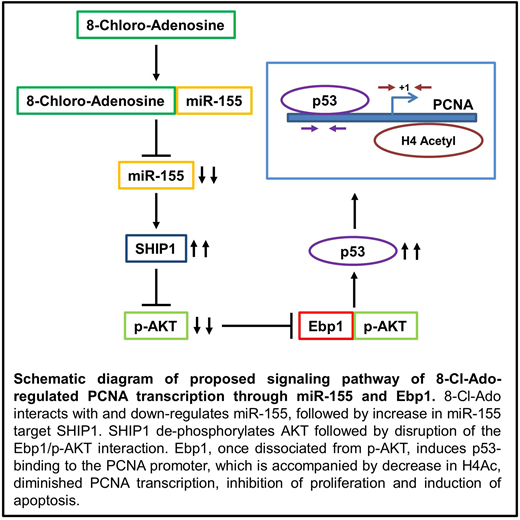Abstract
AML patients (pts) carrying the fms-related tyrosine kinase 3 (FLT3)-internal tandem duplication (ITD) have a poor prognosis. Combination of chemotherapy with tyrosine kinase inhibitors (TKIs) has improved survival of these pts, but a large proportion of them still die of their disease. Nucleoside analogs (NAs) are the backbone of several upfront and salvage chemotherapy regimens for AML, including FLT3-ITD. Although these agents have significant antileukemic activity, they are not effective in eradicating leukemia stem cells (LSCs), the likely reason for treatment failures in AML. Consequently, new strategies are needed to improve the outcome for this and other molecular subsets of AML pts. 8-Cl-Ado is a novel, ribose-containing, RNA-directed nucleoside analog which, different from other NAs, is incorporated into newly transcribed RNA rather than in DNA, causing inhibition of RNA transcription. Among the AML molecular subsets, we identified FLT3-ITD blasts as one of the most sensitive to 8-Cl-Ado; however the mechanism of this differential effect remains unknown. Ex-vivo treatment with 8-Cl-Ado induced dose-dependent growth inhibition and apoptosis in FLT3-ITD AML cell lines and primary blasts including the LSC-enriched CD34+CD38- immunophenotypic subpopulation, with IC50s ranging from 200 nM to 1400 nM and a negligible effect on normal hematopoietic stem cells. In an orthotopic murine model, mice xenografted with FLT3-ITD-positive MV4-11 cells and treated (upon engraftment) with 75 mg 8-Cl-Ado/kg/day through an implanted osmotic pump survived significantly longer than vehicle-treated controls (median survival 45 days vs. 27.3 days, p=0.002). MicroRNA-155 (miR-155) is the most over-expressed miRNA in FLT3-ITD and reportedly plays a key role in FLT3-ITD blast hyper-proliferation [PMID 20656931, PMID 25971362]. Thus, silencing of miR-155 has been proposed as a novel therapeutic approach for FLT3-ITD AML [PMID 25971362]. As 8-Cl-Ado is incorporated mainly into RNA, we reasoned that it could also be incorporated into miR-155 (and other miRNAs). Consistent with our hypothesis, we detected co-localization of 8-Cl-Ado and miR-155 in FLT3-ITD primary blast cells and MV4-11, using fluorescence-labeled 8-Cl-Ado (8-Cl-Ado-FAM) and miR-155 staining (SmartFlare probes), suggesting that 8-Cl-Ado interacts directly with miR-155. Using quantitative RT-PCR we demonstrated ~50% miR-155 down-regulation in 8-Cl-Ado-FAM or 8-Cl-Ado-treated MV4-11 cells and FLT3-ITD primary blast cells, compared to vehicle-treated controls. On a molecular level, 8-Cl-Ado-dependent miR-155 down-regulation was accompanied by up-regulation of SHIP1, a bona fide miR-155 target phosphatase that decreased p-AKT levels thereby negatively regulating FLT3-ITD-dependent AKT signaling required for leukemia cell growth and survival. This effect also disrupted the interaction of AKT and ErbB3 binding protein (Ebp1), a highly expressed protein that regulates p53 expression and prevents DNA fragmentation and apoptosis in normal and leukemic cells. Thus, we hypothesized by disrupting the AKT/Ebp1 interplay via miR-155 down-regulation, 8-Cl-Ado induces pro-apoptotic Ebp1-dependent p53 expression and activation and leukemia cell death. Indeed, we showed that 8-Cl-Ado treatment caused AKT/Ebp1 dissociation and p53 activation in primary FLT3-ITD AML blasts. Conversely, overexpression of miR-155 reversed 8-Cl-Ado-induced apoptosis. By combining 8-Cl-Ado with the TKI quizartinib we elicited a synergistic anti-leukemic effect in primary AML blasts [combination index (CI) values <1 at doses required to inhibit 50, 75, and 90% of cell growth (ED50, ED75, ED90)]. In an orthotopic mouse model where FLT3-ITD-positive MV4-11 cells were xenografted, mice treated with 75 mg 8-Cl-Ado/kg/day plus quizartinib (0.5 mg/kg/day) survived significantly longer than mice treated with the individual agents or vehicle alone (median survival 54.2 days vs. 27.3 days for controls, p=0.016).
Taken together, these results support 8-Cl-Ado as a promising novel agent via a unique mechanism of action for FLT3-ITD AML, mediated by miR-155 degradation. 8-Cl-Ado also synergizes with TKIs both in vitro and in vivo thereby representing a potentially novel clinical approach for FLT3-ITD AML. A single-agent phase I/II clinical trial in relapsed/refractory AML is already ongoing at our institution.
Wennerberg:Novartis: Research Funding. Gandhi:Pharmacyclics: Research Funding.
Author notes
Asterisk with author names denotes non-ASH members.


